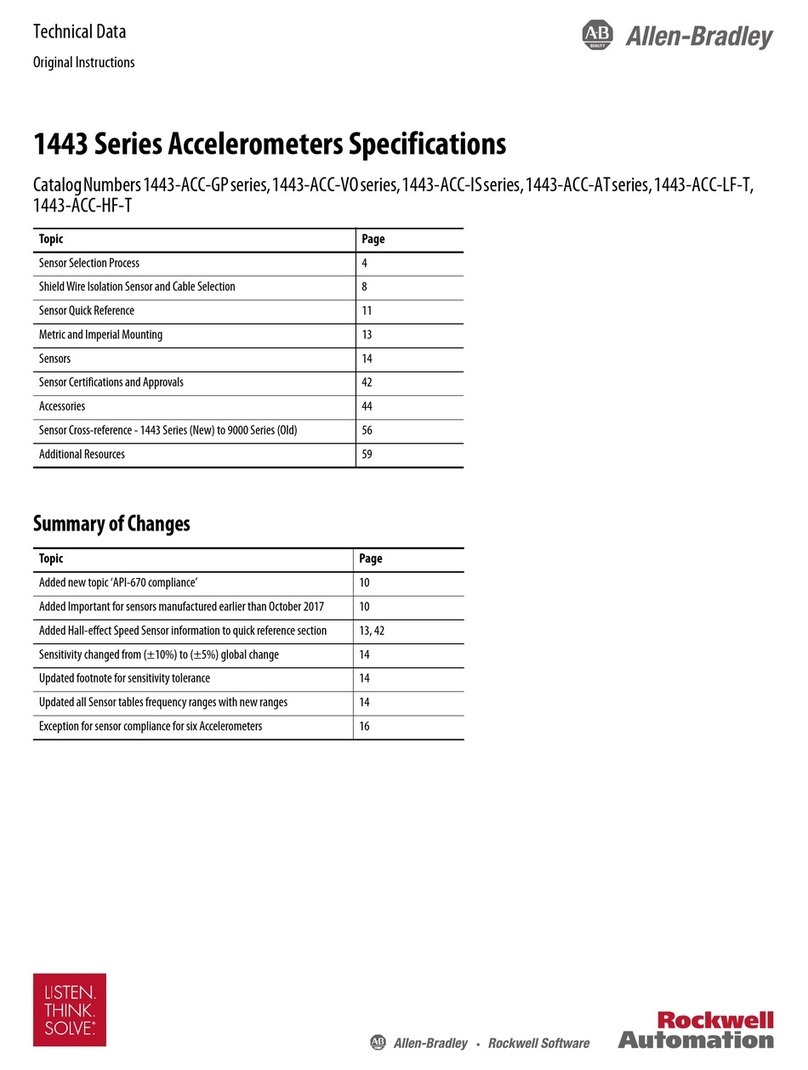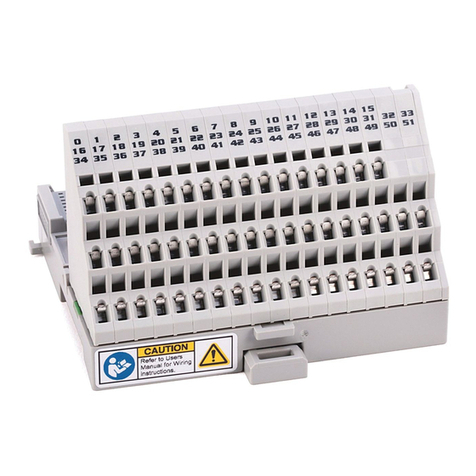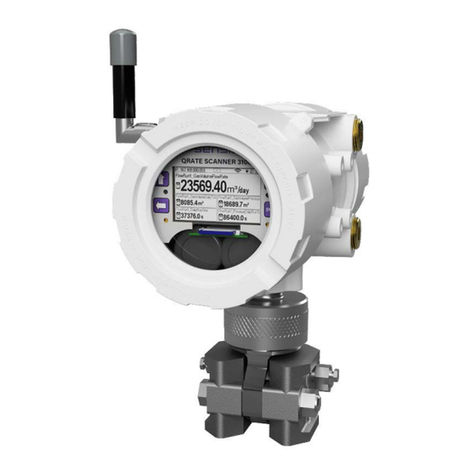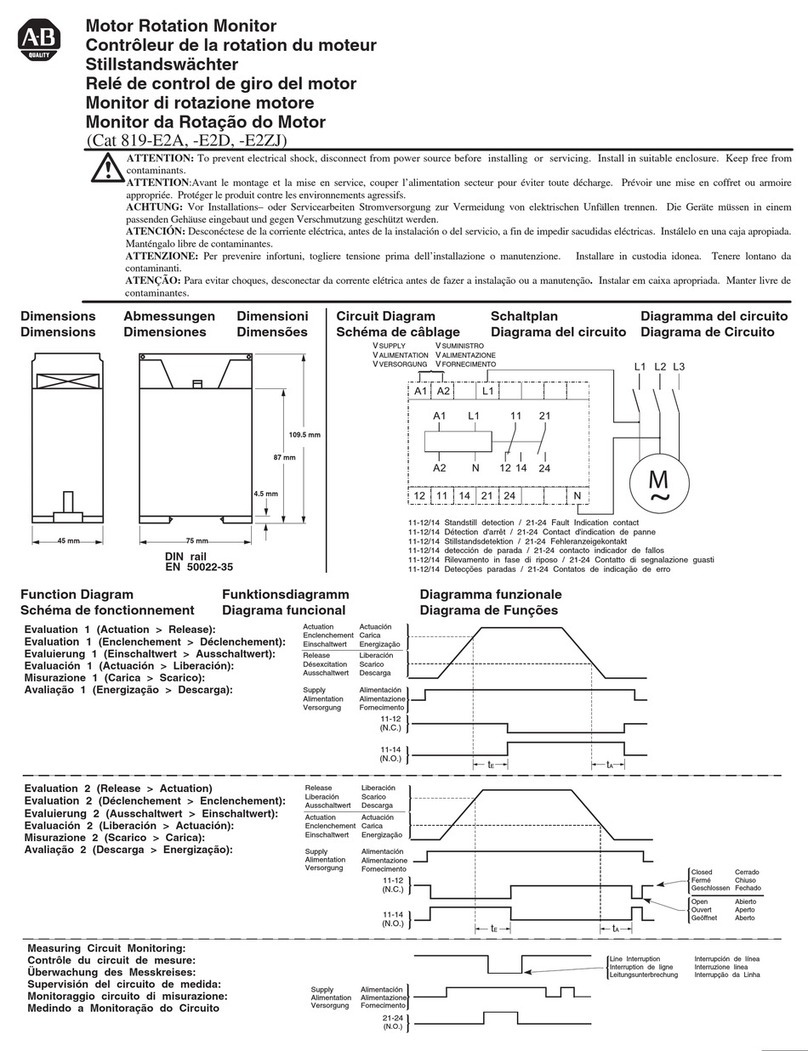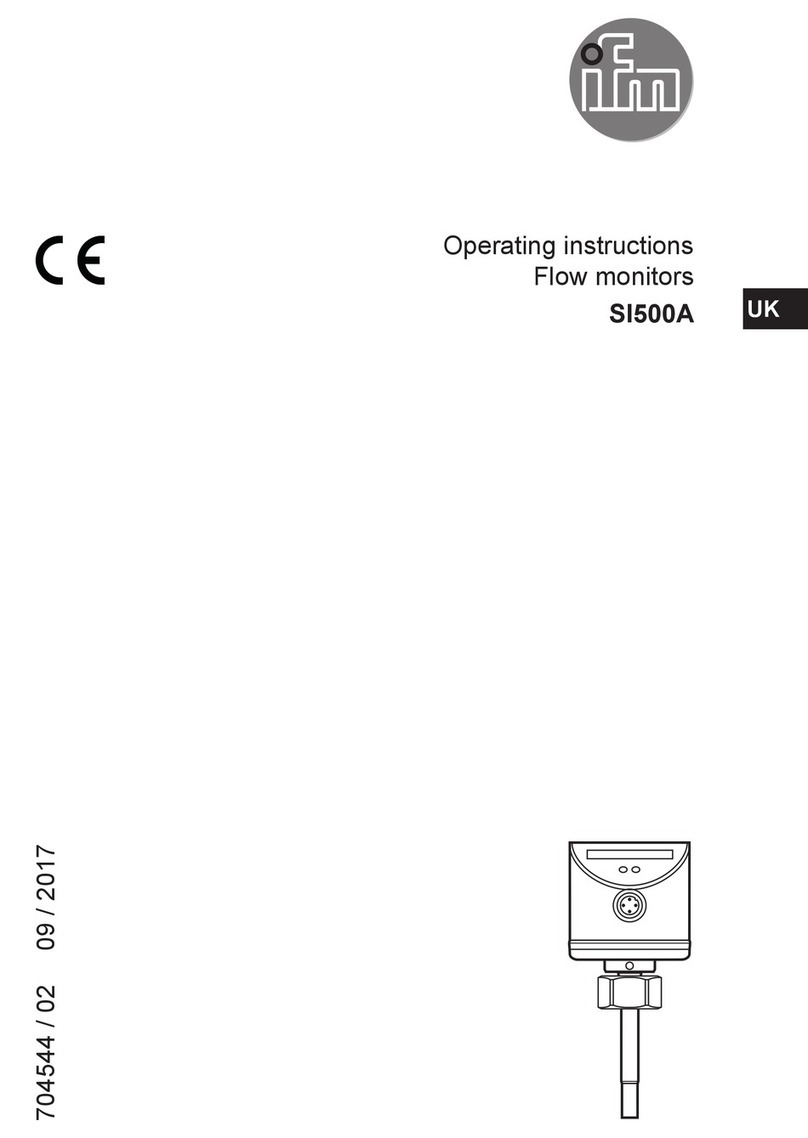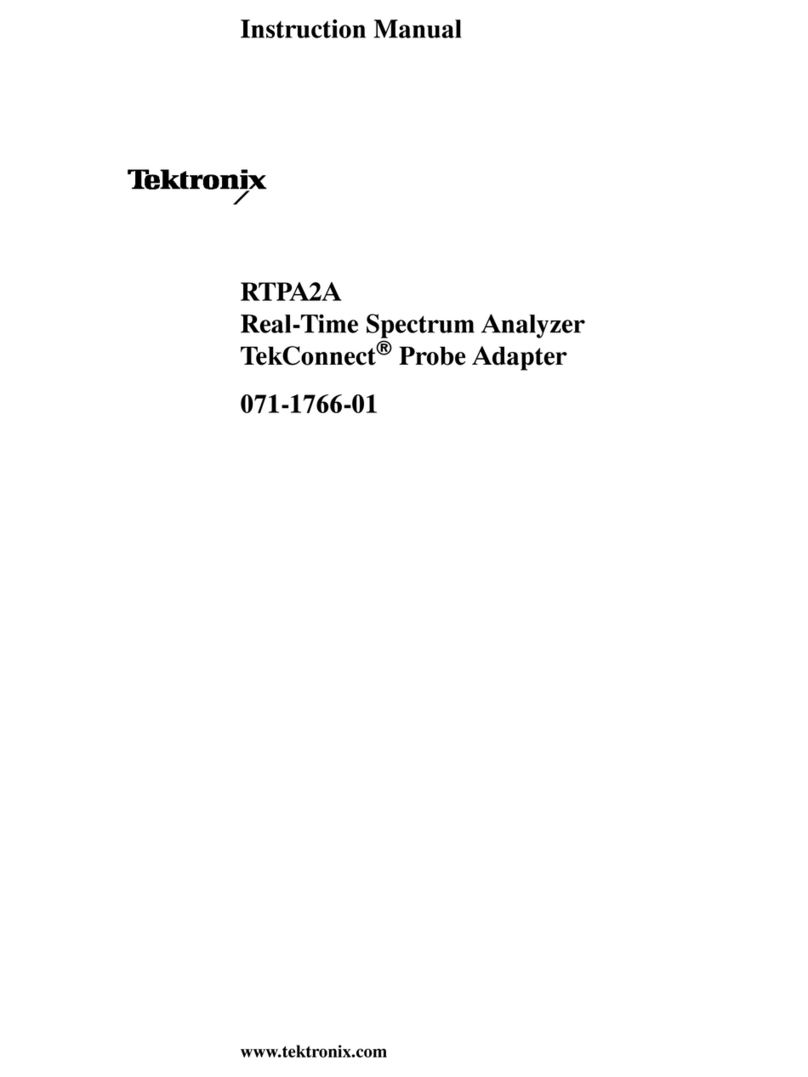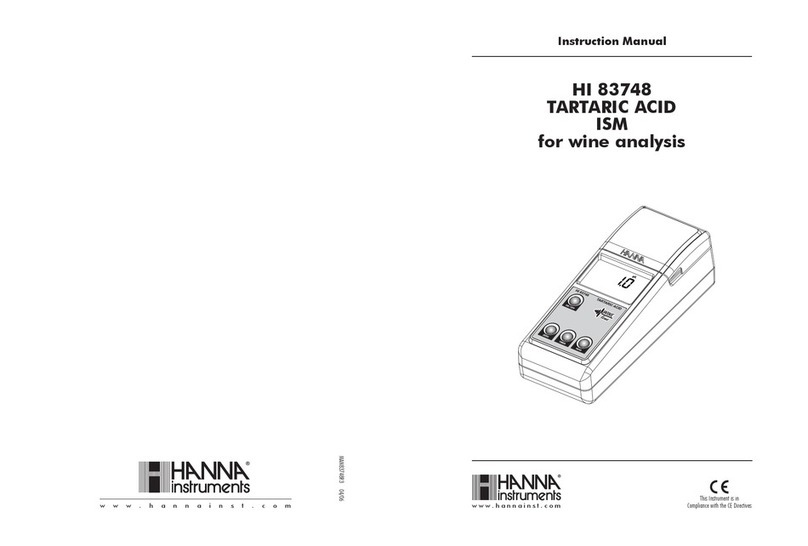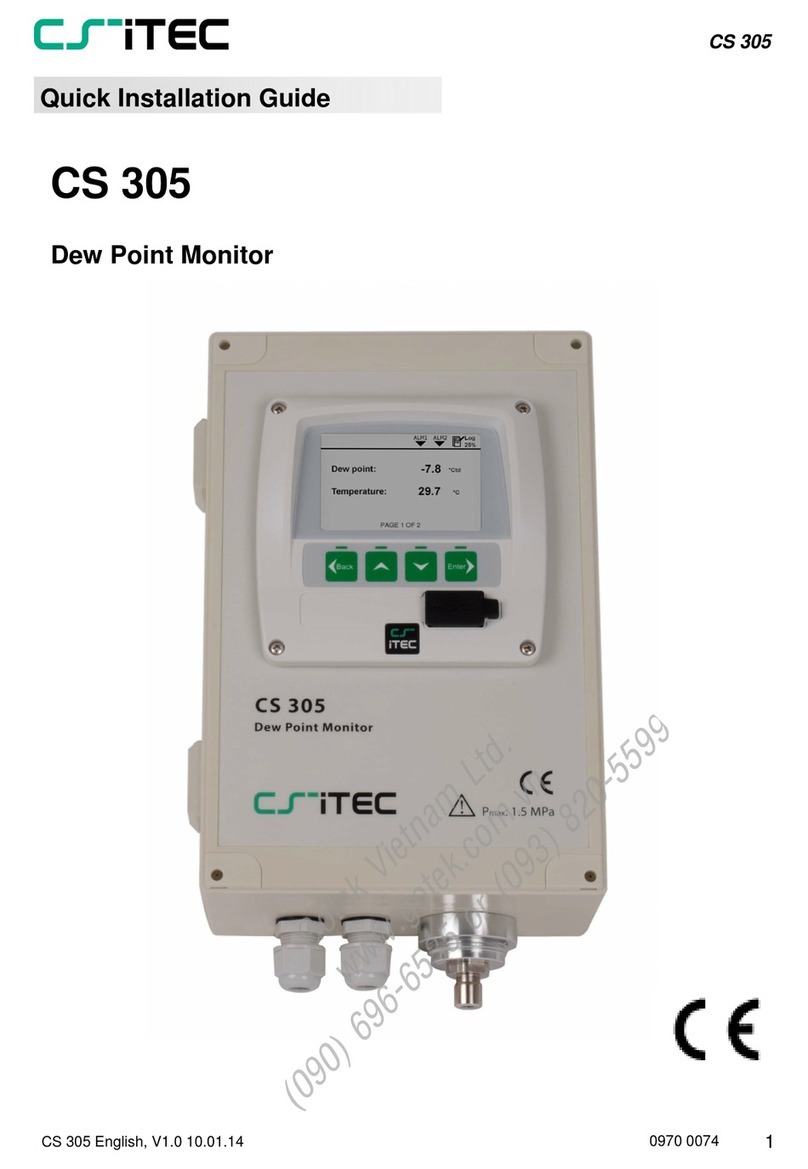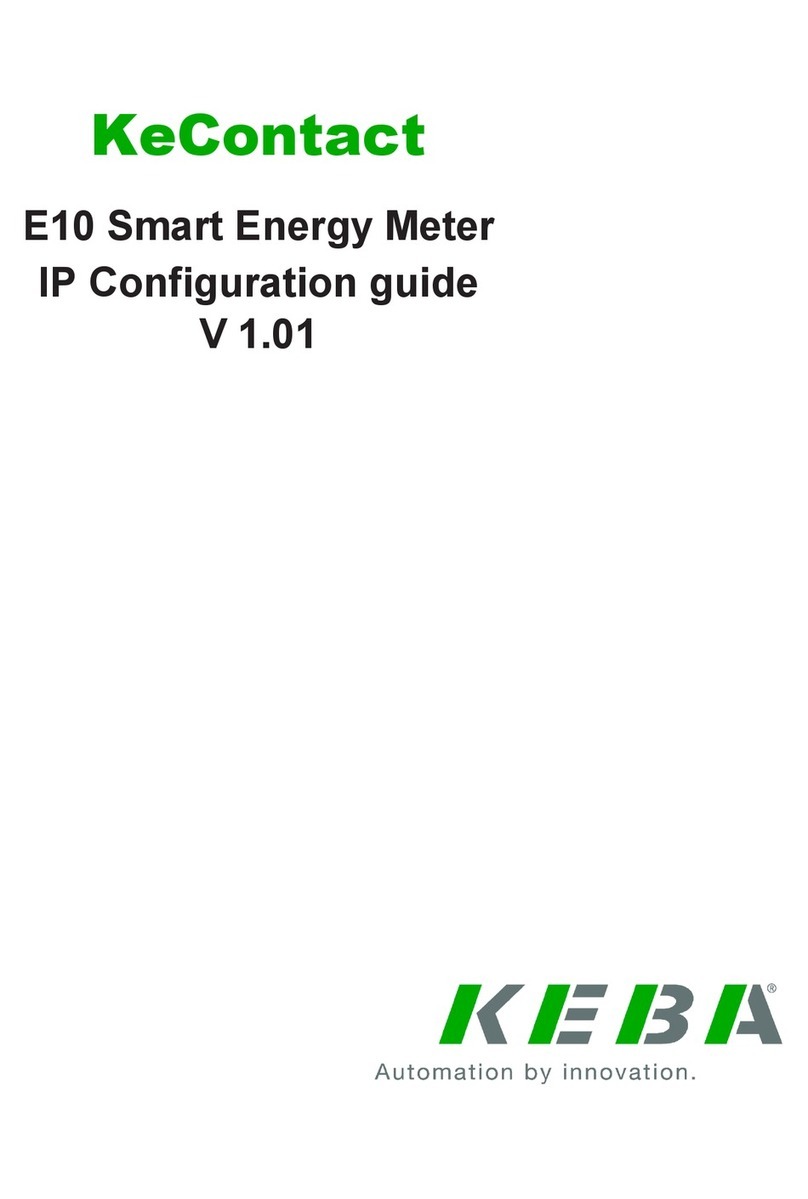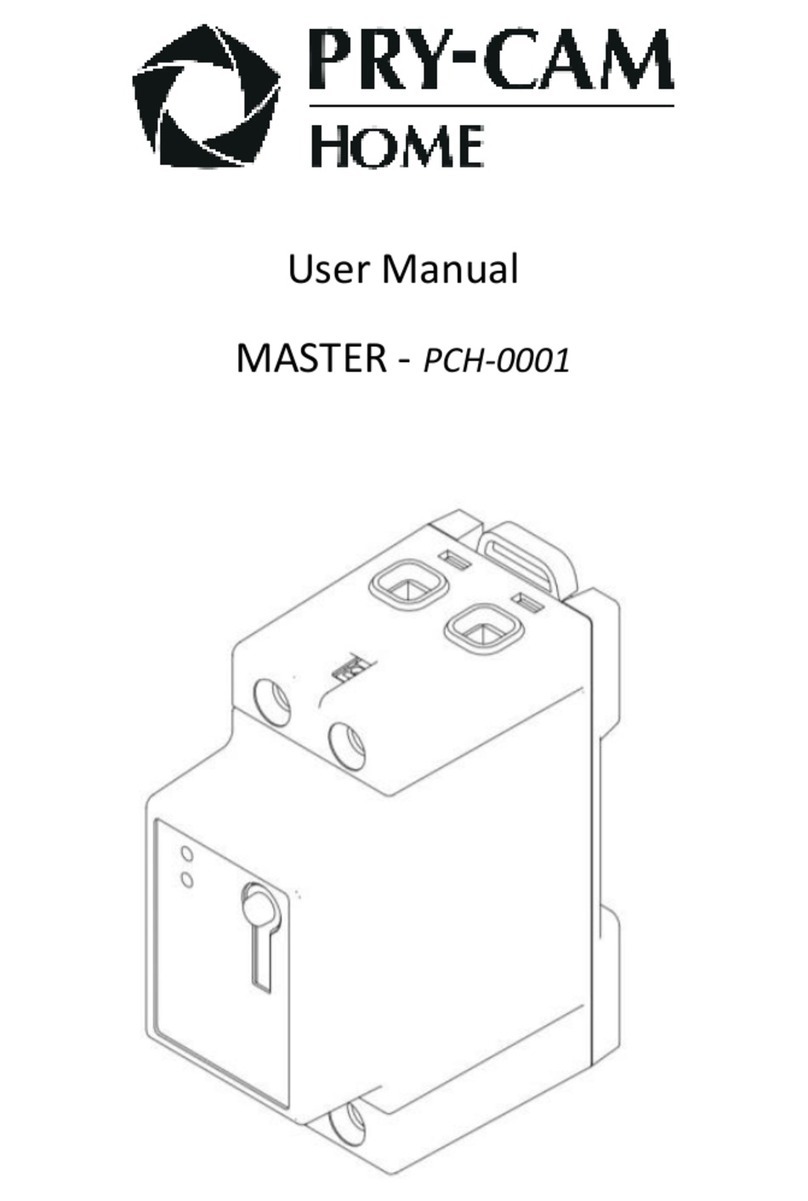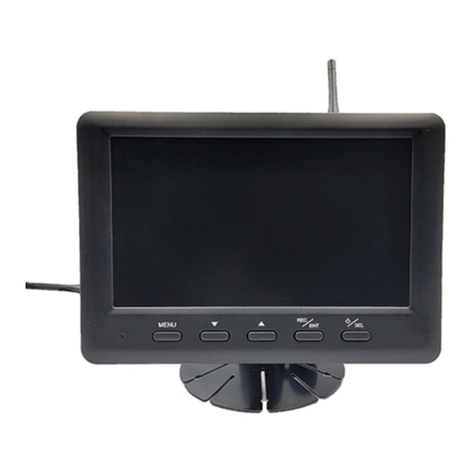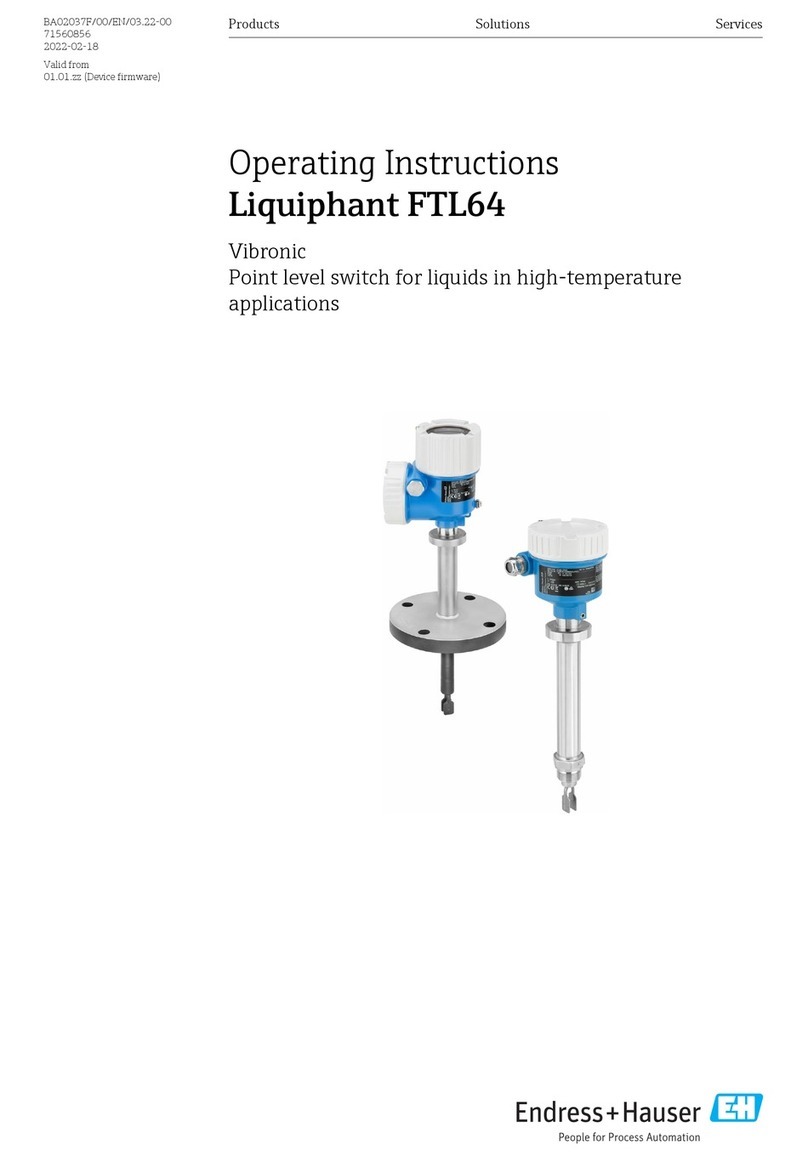Rockwell Automation AB Quality Allen-Bradley 1758-FLO301 Instructions for use

DataSite Electronic Flow Meter and
Remote Terminal Unit
Catalog Numbers 1758-FLO301, 1758-FLO302, 1758-
RTU201, 1758-RTU202
Hardware User Manual

Important User Information
Solid state equipment has operational characteristics differing from those of electromechanical equipment. Safety Guidelines for the Application,
Installation and Maintenance of Solid State Controls (publication SGI-1.1 available from your local Rockwell Automation sales office or online at
http://literature.rockwellautomation.com) describes some important differences between solid state equipment and hard-wired electromechanical
devices. Because of this difference, and also because of the wide variety of uses for solid state equipment, all persons responsible for applying this
equipment must satisfy themselves that each intended application of this equipment is acceptable.
In no event will Rockwell Automation, Inc. be responsible or liable for indirect or consequential damages resulting from the use or application of this
equipment.
The examples and diagrams in this manual are included solely for illustrative purposes. Because of the many variables and requirements associated
with any particular installation, Rockwell Automation, Inc. cannot assume responsibility or liability for actual use based on the examples and
diagrams.
No patent liability is assumed by Rockwell Automation, Inc. with respect to use of information, circuits, equipment, or software described in this
manual.
Reproduction of the contents of this manual, in whole or in part, without written permission of Rockwell Automation, Inc., is prohibited.
Throughout this manual, when necessary, we use notes to make you aware of safety considerations.
Allen-Bradley, Datasite, Rockwell Automation, and TechConnect are trademarks of Rockwell Automation, Inc.
Trademarks not belonging to Rockwell Automation are property of their respective companies.
WARNING
Identifies information about practices or circumstances that can cause an explosion in a hazardous environment, which may
lead to personal injury or death, property damage, or economic loss.
IMPORTANT
Identifies information that is critical for successful application and understanding of the product.
ATTENTION
Identifies information about practices or circumstances that can lead to: personal injury or death, property damage, or
economic loss. Attentions help you identify a hazard, avoid a hazard, and recognize the consequence.
SHOCK HAZARD
Labels may be on or inside the equipment, such as a drive or motor, to alert people that dangerous voltage may be present.
BURN HAZARD
Labels may be on or inside the equipment, such as a drive or motor, to alert people that surfaces may reach dangerous
temperatures.

3Publication 1758-UM001D-EN-P - June 2011
Table of Contents
Table of Contents
Preface
Who Should Use this Manual . . . . . . . . . . . . . . . . . . . . . . . . . . . . . . . . . 5
Purpose of this Manual . . . . . . . . . . . . . . . . . . . . . . . . . . . . . . . . . . . . . . 5
Related Documentation . . . . . . . . . . . . . . . . . . . . . . . . . . . . . . . . . . . . . . 5
Common Techniques Used in this Manual. . . . . . . . . . . . . . . . . . . . . . . 6
Chapter 1
Overview
Introduction . . . . . . . . . . . . . . . . . . . . . . . . . . . . . . . . . . . . . . . . . . . . . . . 7
1758-FLO DataSite controllers. . . . . . . . . . . . . . . . . . . . . . . . . . . . . 8
Features at a Glance. . . . . . . . . . . . . . . . . . . . . . . . . . . . . . . . . . . . . . 8
Controller Description . . . . . . . . . . . . . . . . . . . . . . . . . . . . . . . . . . . . . . . 9
Chapter 2
Installing the Controller
Agency Certifications . . . . . . . . . . . . . . . . . . . . . . . . . . . . . . . . . . . . . . . 11
Compliance to European Union Directives . . . . . . . . . . . . . . . . . . . . . 11
EMC Directive. . . . . . . . . . . . . . . . . . . . . . . . . . . . . . . . . . . . . . . . . 11
Installation Considerations . . . . . . . . . . . . . . . . . . . . . . . . . . . . . . . . . . 11
Safety Considerations. . . . . . . . . . . . . . . . . . . . . . . . . . . . . . . . . . . . . . . 12
Hazardous Location Considerations. . . . . . . . . . . . . . . . . . . . . . . . 12
Environnements dangereux. . . . . . . . . . . . . . . . . . . . . . . . . . . . . . . 13
Disconnecting Main Power . . . . . . . . . . . . . . . . . . . . . . . . . . . . . . . 14
Safety Circuits. . . . . . . . . . . . . . . . . . . . . . . . . . . . . . . . . . . . . . . . . . 14
Power Distribution . . . . . . . . . . . . . . . . . . . . . . . . . . . . . . . . . . . . . 15
Periodic Tests of Master Control Relay Circuit . . . . . . . . . . . . . . . 15
Power Considerations . . . . . . . . . . . . . . . . . . . . . . . . . . . . . . . . . . . . . . 15
Loss of Power Source . . . . . . . . . . . . . . . . . . . . . . . . . . . . . . . . . . . 15
Input States on Power Down . . . . . . . . . . . . . . . . . . . . . . . . . . . . . 16
Other Types of Line Conditions. . . . . . . . . . . . . . . . . . . . . . . . . . . 16
Preventing Excessive Heat. . . . . . . . . . . . . . . . . . . . . . . . . . . . . . . . . . . 16
Master Control Relay . . . . . . . . . . . . . . . . . . . . . . . . . . . . . . . . . . . . . . . 17
Using Emergency-Stop Switches . . . . . . . . . . . . . . . . . . . . . . . . . . 18
Using the Lithium Battery . . . . . . . . . . . . . . . . . . . . . . . . . . . . . . . . . . . 18
Controller Mounting Dimensions . . . . . . . . . . . . . . . . . . . . . . . . . . . . . 19
Controller Spacing . . . . . . . . . . . . . . . . . . . . . . . . . . . . . . . . . . . . . . . . . 19
Mounting the Controller . . . . . . . . . . . . . . . . . . . . . . . . . . . . . . . . . . . . 20
DIN Rail Mounting . . . . . . . . . . . . . . . . . . . . . . . . . . . . . . . . . . . . . 20
Chapter 3
Wiring the Controller
Connectors on the DataSite Controller. . . . . . . . . . . . . . . . . . . . . . . . . 23
Wiring Requirements . . . . . . . . . . . . . . . . . . . . . . . . . . . . . . . . . . . . . . . 24
Wiring Recommendation . . . . . . . . . . . . . . . . . . . . . . . . . . . . . . . . 24
Wiring the Terminal Block . . . . . . . . . . . . . . . . . . . . . . . . . . . . . . . 25
Using Surge Suppressors . . . . . . . . . . . . . . . . . . . . . . . . . . . . . . . . . . . . 26
Recommended Surge Suppressors . . . . . . . . . . . . . . . . . . . . . . . . . 28
Power Source Requirements . . . . . . . . . . . . . . . . . . . . . . . . . . . . . . . . . 28
Grounding the Controller . . . . . . . . . . . . . . . . . . . . . . . . . . . . . . . . . . . 29

Publication 1758-UM001D-EN-P - June 2011
4Table of Contents
Power Wiring . . . . . . . . . . . . . . . . . . . . . . . . . . . . . . . . . . . . . . . . . . . . . 29
I/O Wiring . . . . . . . . . . . . . . . . . . . . . . . . . . . . . . . . . . . . . . . . . . . . . . . 30
Minimizing Electrical Noise . . . . . . . . . . . . . . . . . . . . . . . . . . . . . . 30
Wiring for Analog Input (AI) . . . . . . . . . . . . . . . . . . . . . . . . . . . . . 31
Wiring for Analog Output (AO) . . . . . . . . . . . . . . . . . . . . . . . . . . . 31
Minimizing Electrical Noise on Analog Channels . . . . . . . . . . . . . 32
Grounding Your Analog Cable . . . . . . . . . . . . . . . . . . . . . . . . . . . . 32
Wiring for Digital Input (DI) . . . . . . . . . . . . . . . . . . . . . . . . . . . . . 33
Wiring for Digital Output (DO) . . . . . . . . . . . . . . . . . . . . . . . . . . . 34
Wiring for Pulse Count Input (PI) . . . . . . . . . . . . . . . . . . . . . . . . . 35
Wiring for RS232 Serial Communications . . . . . . . . . . . . . . . . . . . 35
Wiring for RS485 Serial Communications . . . . . . . . . . . . . . . . . . . 39
Wiring for HART Communication. . . . . . . . . . . . . . . . . . . . . . . . . 41
Wiring for Ethernet Communication . . . . . . . . . . . . . . . . . . . . . . . 42
Wiring for Wake Up mode . . . . . . . . . . . . . . . . . . . . . . . . . . . . . . . 45
Chapter 4
Operating the Controller
Operating Modes . . . . . . . . . . . . . . . . . . . . . . . . . . . . . . . . . . . . . . . . . . 47
Run Mode. . . . . . . . . . . . . . . . . . . . . . . . . . . . . . . . . . . . . . . . . . . . . 47
Service Mode . . . . . . . . . . . . . . . . . . . . . . . . . . . . . . . . . . . . . . . . . . 47
Sleep Mode. . . . . . . . . . . . . . . . . . . . . . . . . . . . . . . . . . . . . . . . . . . . 48
LED Indicators . . . . . . . . . . . . . . . . . . . . . . . . . . . . . . . . . . . . . . . . . . . 48
Power Control . . . . . . . . . . . . . . . . . . . . . . . . . . . . . . . . . . . . . . . . . . . . 49
LED Power Control . . . . . . . . . . . . . . . . . . . . . . . . . . . . . . . . . . . . 49
COM1 Power Control . . . . . . . . . . . . . . . . . . . . . . . . . . . . . . . . . . . 49
Ethernet Power Control . . . . . . . . . . . . . . . . . . . . . . . . . . . . . . . . . 50
Counter Input Filters . . . . . . . . . . . . . . . . . . . . . . . . . . . . . . . . . . . . . . . 50
Real-Time Clock. . . . . . . . . . . . . . . . . . . . . . . . . . . . . . . . . . . . . . . . . . . 51
Modbus Register Assignment . . . . . . . . . . . . . . . . . . . . . . . . . . . . . . . . 51
Assigned Modbus Register Addresses of I/O Signals . . . . . . . . . . . . . 52
Analog Scaling . . . . . . . . . . . . . . . . . . . . . . . . . . . . . . . . . . . . . . . . . 52
Scan Settings of Equipment Connected with COMs . . . . . . . . . . . . . . 53
RS485/RS232 Switch Settings. . . . . . . . . . . . . . . . . . . . . . . . . . . . . . . . 53
Communication Parameters . . . . . . . . . . . . . . . . . . . . . . . . . . . . . . . . . 53
Lithium Battery. . . . . . . . . . . . . . . . . . . . . . . . . . . . . . . . . . . . . . . . . . . . 54
Battery Status Check . . . . . . . . . . . . . . . . . . . . . . . . . . . . . . . . . . . . 54
Appendix A
Specifications
Controller Specifications . . . . . . . . . . . . . . . . . . . . . . . . . . . . . . . . . . . . 59
Flow Measurement Parameters . . . . . . . . . . . . . . . . . . . . . . . . . . . . . . . 66

5Publication 1758-UM001D-EN-P - June 2011
Preface
Read this preface to familiarize yourself with the rest of the manual. It
provides information concerning:
•who should use this manual
•the purpose of this manual
•related documentation
•conventions used in this manual
Who Should Use this
Manual
Use this manual if you are responsible for designing, installing, programming,
or troubleshooting control systems that use DataSite controllers.
You should have a basic understanding of electrical circuitry and familiarity
with relay logic. If you do not, obtain the proper training before using this
product.
Purpose of this Manual
This publication is a hardware user manual for DataSite controllers. It
describes the procedures you use to install, wire, and troubleshoot your
controller.
Related Documentation
The publications listed in this table contain more information on the DataSite
controllers.
Related publications for DataSite controllers
Pub. Title Pub. Number Description
DataSite Electronic Flow Meter and Remote Terminal
Unit Installation Instructions 1758-IN001 Information on how to install a DataSite controller.
DataSite Electronic Flow Meter and Remote Terminal
Unit Software Tools User Manual 1758-UM002 Information on how to install and use the software tools,
DS Settings, DS FloConfig, and DS DNP3 to configure and
monitor DataSite controllers.
Customized Function Blocks for DataSite Reference
Manual 1758-RM001 Description of the customized function blocks used for
programming DataSite controllers.
DataSite Screen Builder user documentation available on
the DataSite CD and from http://www.isagraf.com — Information on using the DataSite Screen Builder to create
graphical user interfaces.
DataSite Workbench user documentation available on the
DataSite CD and from http://www.isagraf.com — Information on using the DataSite Workbench to develop
multi-process control projects for use with DataSite
controllers.
Modbus Protocol Specifications Available from
www.modbus.org — Information about the Modbus protocol.
Allen-Bradley Programmable Controller Grounding and
Wiring Guidelines 1770-4.1 In-depth information on grounding and wiring Allen-Bradley
programmable controllers.
Application Considerations for Solid-State Controls SGI-1.1 A description of important differences between solid-state
programmable controller products and hard-wired
electromechanical devices.

Publication 1758-UM001D-EN-P - June 2011
6Preface
Common Techniques Used
in this Manual
The following conventions are used throughout this manual:
•Bulleted lists such as this one provide information, not procedural steps.
•Numbered lists provide sequential steps or hierarchical information.
•Italic type is used for emphasis.
National Electrical Code - Published by the National Fire
Protection Association of Boston, MA. — An article on wire sizes and types for grounding electrical
equipment.
Allen-Bradley Publication Index SD499 — A complete listing of current documentation, including
ordering instructions. Also indicates whether the
documents are available on CD-ROM or in multi-languages.
Allen-Bradley Industrial Automation Glossary AG-7.1 A glossary of industrial automation terms and
abbreviations.
Related publications for DataSite controllers (Continued)
Pub. Title Pub. Number Description

7Publication 1758-UM001D-EN-P - June 2011
Chapter
1
Overview
Introduction
The Allen-Bradley DataSite controller is an excellent remote terminal unit for
service in harsh and extreme industrial environments such as oil, gas, pipeline,
and electrical utility applications. It is ideal for applications that require wide
temperature ratings and low power consumption, and applications that are
remote and powered by solar cells or wind power.
The DataSite controller has a high-performance 32-bit ARM processor with
several communications options. An Ethernet port, two serial ports
(RS232/RS485) and one HART multi drop interface are built in. Native
protocols include Modbus RTU, Modbus ASCII, Modbus TCP/IP and
DNP 3.0.
The DataSite controller can store a total of:
•700 event records
•300 alarm records
•Hourly records of up to 35 days for each meter run
A maximum of 30 items for each day can be stored.
•Daily records of up to 35 days for each meter run
The DataSite controller can be programmed by using DataSite Workbench.
Workbench is a software environment designed to facilitate the task of
automation throughout the life cycle of a system, from system design to
commissioning, operation, and maintenance. To view valves, pumps and
meters over the Internet, use DataSite Screen Builder. Screen Builder is an
embedded web technology which allows the DataSite controller to act as a web
and event-based data server.

Publication 1758-UM001D-EN-P - June 2011
8Overview
1758-FLO DataSite controllers
In addition to the features listed in preceding sections, the 1758-FLO DataSite
controllers provide the additional feature of being able to calculate gas flow.
1758-FLO DataSite controllers contain the 1758-FLO flow measurement
algorithm which conforms to the following standards:
•AGA-3 (1992 version)(1) orifice metering of natural gas and other
related hydrocarbon fluids;
•AGA-7(1) measurement of gas by turbine meters;
•AGA-8(1) compressibility factors of natural gas and other related
hydrocarbon gases.
The 1758-FLO controller can be configured by using the DS FloConfig
software. This tool provides functions such as reading and revising parameters,
reading historical data and monitoring measurement results.
Features at a Glance
•Advanced 32-bit processor with embedded real-time multi-task
operating system (RTOS).
•8 analog inputs (2 with point-to-point HART interface), 2 analog out, 8
discrete inputs, 4 discrete outputs, and 3 pulse inputs.
•Embedded Ethernet, two serial ports (RS232/RS485) and one HART
multi-drop interface; native protocols include Modbus RTU, Modbus
ASCII, and Modbus TCP.
•6M Flash, 1M RAM, and 32K ferroelectric RAM for long-term storage
of configured parameters.
•HiBeam technology that allows the DataSite controller to act as a web
and event-based data server. HiBeam also has tools for interfacing with
your controller-based data through a standard web browser.
•Conformity to IEC61131-3. Supports LD, FBD, IL, ST and SFC
programming languages.
•Isolation of power supply, signal output and input terminals from the
main control circuit.
•Standard industrial design and DIN rail mounting option, which are
convenient for field installation and configuring interior hardware.
(1) The 1758-RTU controller does not have AGA-3, AGA-7 or AGA-8 calculations.

Publication 1758-UM001D-EN-P - June 2011
Overview 9
•Working temperature of -40…70 °C, humidity: 5…95% RH, which is
applicable for a range of different environments.
Controller Description
The components of the DataSite controller are shown here.
Item Description
1 Discrete Input and wake-up connectors
2 Status indicators
3 Ethernet connector
4 RS232 COM 2 connector
5 RS232 COM 1 connector
6 RS485 COM 1 connector
7 Discrete Output connectors
8 Power Input and Analog Input connectors
9 HART, Pulse Input, and Analog Output connectors
10 Pulse Input Filter switches
DICOM
DI0
V+ V- AI0 AI1 AI2 AI3 AI4 AI5 V- DO0 DO1 DO2 DO3 VDO+ VDO-
DI1 DI2 DI3 DI4 DI5 DI6 DI7 WAKEUP
+_
Data
+_
19
20 21 22 23 24 25 26 27 28 29
23456789101111213141516
17 18
P11P10H2-H2+H1-H1+H0-H0+ P12 PI
COM AOV+AOV-AO0AOV-AO1 AOV-
ON
0
1
2
3736353433323130 38 39 40 41 42 43 44 45
44376
1 2 3
45678
9
10
44379

Publication 1758-UM001D-EN-P - June 2011
10 Overview
Notes:

11 Publication 1758-UM001D-EN-P - June 2011
Chapter
2
Installing the Controller
This chapter shows you how to install the DataSite controller. The only tool
you require is a Phillips head screwdriver.
Agency Certifications
•UL Listed Industrial Control Equipment for use in Class I, Division 2,
Hazardous Locations, Groups A, B, C, D
•cULus Listed Industrial Control Equipment for use in Canada
•CE marked for all applicable directives
•C-Tick marked for all applicable acts
Compliance to European
Union Directives
This product has the CE mark and is approved for installation within the
European Union and EMEA regions. It has been designed and tested to meet
the following directives.
EMC Directive
This product is tested to meet Council Directive 89/336/EEC
Electromagnetic Compatibility (EMC) and the following standards, in whole
or in part, documented in a technical construction file:
•EN 61000-6-4EMC - Part 6-4: Generic Standards - Emission Standard
for Industrial Environments
•EN 61000-6-2EMC - Part 6-2: Generic Standards - Immunity for
Industrial Environments
This product is intended for use in an industrial environment.
Installation Considerations
Most applications require installation in an industrial enclosure (Pollution
Degree 2(1)) to reduce the effects of electrical interference (Over Voltage
Category II(2)) and environmental exposure.
(1) Pollution Degree 2 is an environment where, normally, only non-conductive pollution occurs except that
occasionally a temporary conductivity caused by condensation shall be expected.
(2) Over Voltage Category II is the load level section of the electrical distribution system. At this level transient
voltages are controlled and do not exceed the impulse voltage capability of the product’s insulation.

Publication 1758-UM001D-EN-P - June 2011
12 Installing the Controller
Locate your controller as far as possible from power lines, load lines, and other
sources of electrical noise such as hard-contact switches, relays, and AC motor
drives. For more information on proper grounding guidelines, see the Industrial
Automation Wiring and Grounding Guidelines, publication 1770-4.1.
Safety Considerations
Safety considerations are an important element of proper system installation.
Actively thinking about the safety of yourself and others, as well as the
condition of your equipment, is of primary importance. We recommend
reviewing the following safety considerations.
Hazardous Location Considerations
This equipment is suitable for use in Class I, Division 2, Groups A, B, C, D
locations only. The following WARNING statement applies to use in
hazardous locations.
ATTENTION
Electrostatic discharge can damage semiconductor devices
inside the controller. Do not touch the connector pins or other
sensitive areas.
ATTENTION
Be careful of metal chips when drilling mounting holes for your
controller or other equipment within the enclosure or panel.
Drilled fragments that fall into the controller could cause
damage. Do not drill holes above a mounted controller if the
protective debris strips have been removed.
WARNING
EXPLOSION HAZARD
•Substitution of components may impair suitability for
Class I, Division 2.
•Do not replace components or disconnect equipment unless
power has been switched off.
•Do not connect or disconnect components unless power
has been switched off.
•This product must be installed in an enclosure. All cables
connected to the product must remain in the enclosure or
be protected by conduit or other means.
•All wiring must comply with N.E.C. article 501-10(b).

Publication 1758-UM001D-EN-P - June 2011
Installing the Controller 13
Use only the following communication cables in Class I, Division 2 hazardous
locations.
Environnements dangereux
Cet équipement est conçu pour une utilisation en environnements dangereux
de Classe I, Division 2, Groupes A, B, C, D. La mise en garde suivante
s’applique à utilisation en environnements dangereux.
Utilisez uniquement les câbles de communication suivants dans les
environnements dangereux de Classe I, Division 2.
Communication Cables for Class I, Division 2 Hazardous Locations
Description Catalog No.
This 3.96 m (12 ft) cable has two 9-pin DTE connectors and is used
to connect the RS232 channel (Channel 1 or 2) on the DataSite
controller to a serial port on a personal computer.
1747-CP3
WARNING
DANGER D’EXPLOSION
•La substitution de composants peut rendre cet
équipement impropre à une utilisation en
environnement de Classe I, Division 2.
•Ne pas remplacer de composants ou déconnecter
l’équipement sans s’être assuré que l’alimentation est
coupée.
•Ne pas connecter ou déconnecter des composants sans
s’être assuré que l’alimentation est coupée.
•Ce produit doit être installé dans une armoire. Tous les
câbles connectés à l’appareil doivent rester dans
l’armoire ou être protégés par une goulotte ou tout
autre moyen.
•L’ensemble du câblage doit être conforme à la
réglementation en vigueur dans les pays où l’appareil est
installé.
Classification des environnements Câbles de communication
Environnement dangereux de Classe I,
Division 2 1747-CP3 RS232 Serial Communications Cable

Publication 1758-UM001D-EN-P - June 2011
14 Installing the Controller
Disconnecting Main Power
The main power disconnect switch should be located where operators and
maintenance personnel have quick and easy access to it. In addition to
disconnecting electrical power, all other sources of power (pneumatic and
hydraulic) should be de-energized before working on a machine or process
controlled by a controller.
Safety Circuits
Circuits installed on the machine for safety reasons, like overtravel limit
switches, stop push buttons, and interlocks, should always be hard-wired
directly to the master control relay. These devices must be wired in series so
that when any one device opens, the master control relay is de-energized,
thereby removing power to the machine. Never alter these circuits to defeat
their function. Serious injury or machine damage could result.
WARNING
Explosion Hazard
Do not replace components, connect equipment, or disconnect
equipment unless power has been switched off.
WARNING
Explosion Hazard
Do not connect or disconnect connectors while circuit is live.

Publication 1758-UM001D-EN-P - June 2011
Installing the Controller 15
Power Distribution
There are some points about power distribution that you should know:
•The master control relay must be able to inhibit all machine motion by
removing power to the machine I/O devices when the relay is
de-energized. It is recommended that the controller remain powered
even when the master control relay is de-energized.
•If you are using a DC power supply, interrupt the load side rather than
the AC line power. This avoids the additional delay of power supply
turn-off. The DC power supply should be powered directly from the
fused secondary of the transformer. Power to the DC input and output
circuits should be connected through a set of master control relay
contacts.
Periodic Tests of Master Control Relay Circuit
Any part can fail, including the switches in a master control relay circuit. The
failure of one of these switches would most likely cause an open circuit, which
would be a safe power-off failure. However, if one of these switches shorts
out, it no longer provides any safety protection. These switches should be
tested periodically to assure they will stop machine motion when needed.
Power Considerations
The following explains power considerations for the DataSite controller.
Loss of Power Source
The power supply is designed to withstand brief power losses without
affecting the operation of the system. The time the system is operational
during power loss is called program scan hold-up time after loss of power.
The duration of the power supply hold-up time depends on the type and state
of the I/O, but is typically between 10 milliseconds and 3 seconds. When the
duration of power loss reaches this limit, the power supply signals the
processor that it can no longer provide adequate DC power to the system.
This is referred to as a power supply shutdown. The processor then performs
an orderly shutdown of the controller.

Publication 1758-UM001D-EN-P - June 2011
16 Installing the Controller
Input States on Power Down
The power supply hold-up time as described above is generally longer than the
turn-on and turn-off times of the inputs. Because of this, the input state
change from On to Off that occurs when power is removed may be recorded
by the processor before the power supply shuts down the system.
Understanding this concept is important. The user program should be written
to take this effect into account.
Other Types of Line Conditions
Occasionally the power source to the system can be temporarily interrupted. It
is also possible that the voltage level may drop substantially below the normal
line voltage range for a period of time. Both of these conditions are considered
to be a loss of power for the system.
Preventing Excessive Heat
For most applications, normal convective cooling keeps the controller within
the specified operating range. Ensure that the specified temperature range is
maintained. Proper spacing of components within an enclosure is usually
sufficient for heat dissipation.
In some applications, a substantial amount of heat is produced by other
equipment inside or outside the enclosure. In this case, place blower fans
inside the enclosure to assist in air circulation and to reduce ‘hot spots’ near
the controller.
Additional cooling provisions might be necessary when high ambient
temperatures are encountered.
TIP
Do not bring in unfiltered outside air. Place the controller in an
enclosure to protect it from a corrosive atmosphere. Harmful
contaminants or dirt could cause improper operation or damage
to components.

Publication 1758-UM001D-EN-P - June 2011
Installing the Controller 17
Master Control Relay
A hard-wired master control relay (MCR) provides a reliable means for
emergency machine shutdown. Since the master control relay allows the
placement of several emergency-stop switches in different locations, its
installation is important from a safety standpoint. Overtravel limit switches or
mushroom-head push buttons are wired in series so that when any of them
opens, the master control relay is de-energized. This removes power to input
and output device circuits.
Place the main power disconnect switch where operators and maintenance
personnel have quick and easy access to it. If you mount a disconnect switch
inside the controller enclosure, place the switch operating handle on the
outside of the enclosure, so that you can disconnect power without opening
the enclosure.
Whenever any of the emergency-stop switches are opened, power to input and
output devices should be removed.
When you use the master control relay to remove power from the external
I/O circuits, power continues to be provided to the controller’s power supply
so that diagnostic indicators on the processor can still be observed.
The master control relay is not a substitute for a disconnect to the controller.
It is intended for any situation where the operator must quickly de-energize
I/O devices only. When inspecting or installing terminal connections,
replacing output fuses, or working on equipment within the enclosure, use the
disconnect to shut off power to the rest of the system.
ATTENTION
Never alter these circuits to defeat their function since serious
injury and/or machine damage could result.
TIP
If you are using an external DC power supply, interrupt the DC
output side rather than the AC line side of the supply to avoid
the additional delay of power supply turn-off.
The AC line of the DC output power supply should be fused.
Connect a set of master control relays in series with the DC
power supplying the input and output circuits.
TIP
Do not control the master control relay with the controller.
Provide the operator with the safety of a direct connection
between an emergency-stop switch and the master control
relay.

Publication 1758-UM001D-EN-P - June 2011
18 Installing the Controller
Using Emergency-Stop Switches
When using emergency-stop switches, adhere to the following points:
•Do not program emergency-stop switches in the controller program.
Any emergency-stop switch should turn off all machine power by
turning off the master control relay.
•Observe all applicable local codes concerning the placement and
labeling of emergency-stop switches.
•Install emergency-stop switches and the master control relay in your
system. Make certain that relay contacts have a sufficient rating for your
application. Emergency-stop switches must be easy to reach.
•In the following illustration, input and output circuits are shown with
MCR protection. However, in most applications, only output circuits
require MCR protection.
Using the Lithium Battery
The DataSite controller is equipped with a non-replaceable lithium battery that
is fixed onto a battery seat on the circuit board.
For more information on the battery, see Lithium Battery on page 54.
TIP
In most applications input circuits do not require MCR
protection; however, if you need to remove power from all field
devices, you must include MCR contacts in series with input
power wiring.
IMPORTANT
Contact your local Rockwell Automation representative to
arrange for a battery replacement if the battery needs to be
replaced.

Publication 1758-UM001D-EN-P - June 2011
Installing the Controller 19
Controller Mounting
Dimensions
The dimensions of the DataSite controller are shown in this diagram.
The dimensions are identical for all DataSite catalog numbers.
1758-FLO301, 1758-FLO302, 1758-RTU201, 1758-RTU202
Controller Spacing
When mounting the controller, allow 25 mm (1 in.) of space on all sides for
adequate ventilation. Maintain spacing from enclosure walls, wireways,
adjacent equipment, and the like, as shown below.
Front view
13.0 cm
(5.12 in)
21.3 cm
(8.395 in) 44374
Side view
5.6 cm
(2.20 in)
Top
Bottom
Side Side
44375

Publication 1758-UM001D-EN-P - June 2011
20 Installing the Controller
Mounting the Controller
DataSite controllers are suitable for use in an industrial environment when
installed in accordance with these instructions. Specifically, this equipment is
intended for use in clean, dry environments (Pollution degree 2(1)) and to
circuits not exceeding Over Voltage Category II(2) (IEC 60664-1).(3)
DIN Rail Mounting
You can mount the controller either horizontally or vertically on DIN rails,
but horizontal mounting is recommended for thermal considerations. You
need a small Phillips head screwdriver for the installation or removal of the
controller. You can mount the controller on EN50022-35x7.5 DIN rails.
Follow these steps to install your controller on the DIN rail.
1. Mount your DIN rail.
Make sure that the placement of the controller on the DIN rail meets
the recommended spacing requirements. See Controller Spacing on page
19.
2. Loosen the two clamp screws until the clamp can slide out.
3. Place the controller onto the DIN rail, using the rail hooks on the back
of the controller.
(1) Pollution Degree 2 is an environment where, normally, only non-conductive pollution occurs except that
occasionally a temporary conductivity caused by condensation shall be expected.
ATTENTION
Electrostatic discharge can damage semiconductor devices
inside the controller. Do not touch the connector pins or other
sensitive areas.
(2) Over Voltage Category II is the load level section of the electrical distribution system. At this level transient
voltages are controlled and do not exceed the impulse voltage capability of the product’s insulation.
(3) Pollution Degree 2 and Over Voltage Category II are International Electrotechnical Commission (IEC)
designations.
IMPORTANT
Do not remove the screws from the clamp, otherwise they will
drop into the chassis.
This manual suits for next models
3
Table of contents
Other Rockwell Automation Measuring Instrument manuals
Popular Measuring Instrument manuals by other brands
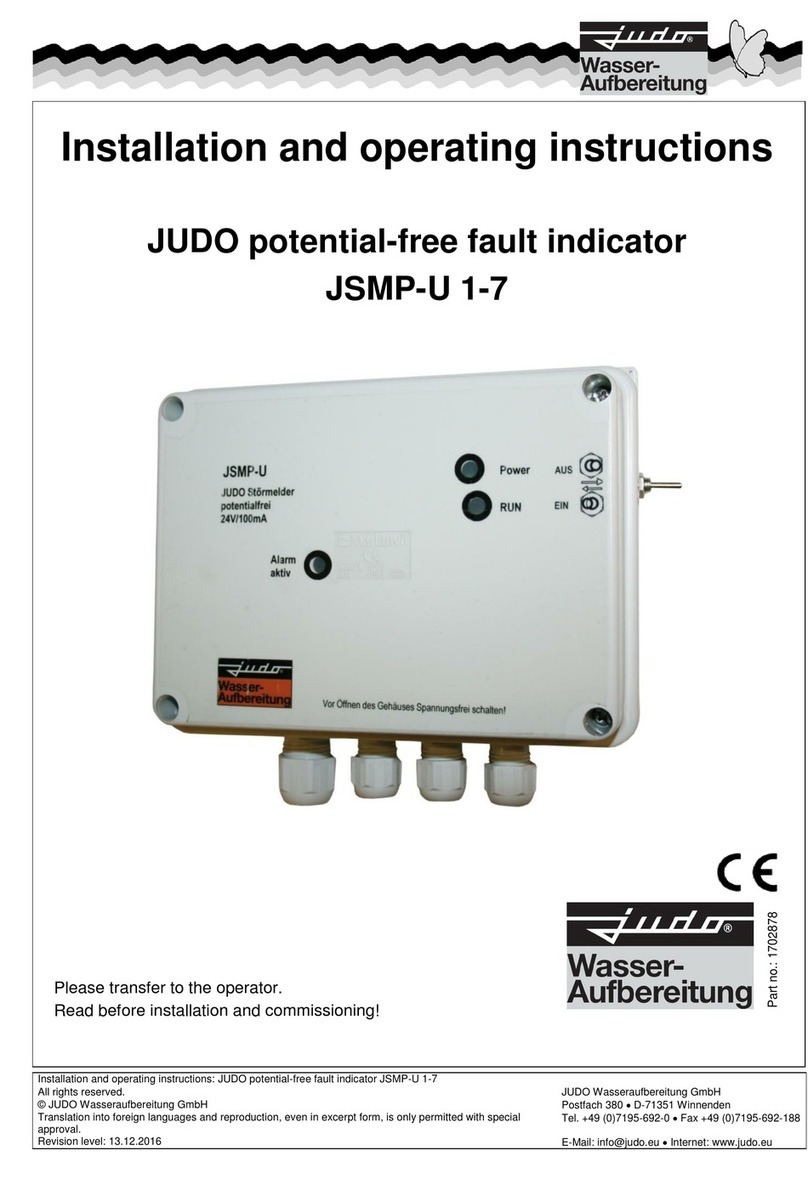
Judo
Judo JSMP-U 1 Installation and operating instructions

SevenStar
SevenStar CS200-J user manual

TSI Instruments
TSI Instruments Quest The Edge quick start guide

Endress+Hauser
Endress+Hauser StamoLys CA 71 CU operating instructions

Waeco
Waeco MAGIC Control MTPM-100 Installation and operation manual

ETAS
ETAS ETK-T2.2G user guide
